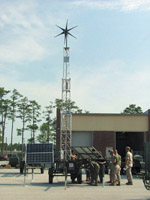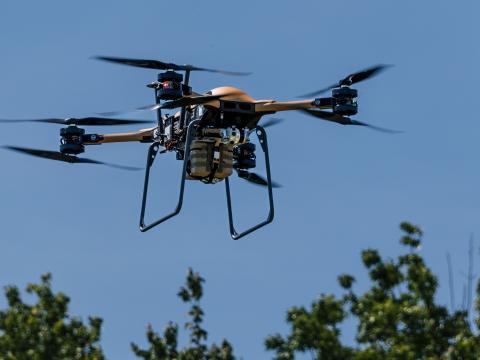Marines Test Their Mojo
 |
| The Marine Corps is testing and evaluating Mojos—power sources that rely on sun and wind rather than fossil fuels. The Marines are testing the systems for use in applications from sensor suites to communications. |
The U.S. Marine Corps is going green, but not through any recycling program or base initiative. Rather, the military service is testing the applicability of harnessing the power of the sun and wind to operate combat communications and other systems. The initiative not only eliminates the need for traditional fossil fuels and the logistics necessary to supply them, but also reduces heat and noise signatures so troops can minimize detection.
The Marines are testing two Mojos—pronounced the way the movie character Austin Powers would, as opposed to the beginning of a popular Cuban beverage—for their feasibility in combat. The products are road-ready, rapidly deployable trailers that include a 26-foot telescoping tower, battery box and complex set of electronics as well as four solar panels and a wind generator. Mojos typically produce approximately 520 watts of sustained solar power, and the wind turbines generate 350 to 600 watts of sustained power.
The use of natural power sources eliminates the need for grid-based power, suiting Mojos for use in remote environments such as those in combat or border patrol situations. The systems can handle a variety of payloads to support missions such as intelligence, surveillance and reconnaissance or communications. The balance of solar and wind power built into the Mojos enables them to operate through various environmental occurrences such as at night when solar power is not available or during calm weather when wind is absent.
The 8th Communications Battalion at
Officials with the 8th Communications Battalion and MARCORSYSCOM confirm the purchase of the systems as well as the testing and evaluation of them. Officials at
The Marine Corps is conducting its testing using an automated data recorder that monitors the power that solar and wind components produce separately and how this meets the needs of given simulated loads. According to officials at MARCORSYSCOM, the Marines currently have solutions in the 100-watt and below range as well as the 3- to 5-kilowatt range and are “looking for something to fill the 100- to 500-watt range.” Because the Marine Corps is still in the testing phase, the service branch declines to offer specific comments about the systems, including their performance thus far.
The Marines at
One of the ways CPSI designed the Mojo to ensure users obtain the power they need is by including a large battery bank on the system. The wattage output of the Mojos represents sustained power levels for regular use and activities. However, the battery bank on the trailer is a large capacitor that can deliver five to six times more power for shorter durations. Pat Gallagher, president, CPSI, says the system could produce a kilowatt of power, but such output would be short-lived.
Gallagher explains that his company prefers to work closely with its customers to understand fully what devices they will use with the power source and how much power is needed. CPSI strives to understand what problems the end user hopes to solve with Mojos and works with its integrators or sales personnel to create the product clients need. “Nobody buys alternate power just to buy alternate power,” Gallagher says. “They’re buying it for a solution.” The products are fine-tuned for their applications and are in constant evolution as users define new requirements.
He shares that there are three pieces to the puzzle to ensure users receive maximum benefit from Mojos. The first piece is power generation; the second is power storage, the battery system; and the third is power delivery to guarantee that the tools people use with Mojos balance correctly in terms of power draw. Optimizing the system also entails knowing how long users plan to employ Mojos in a situation to make sure the system works for that amount of time, whether that is a day, a week or a year deployment. A constant power supply is necessary for mission-critical military communications as well as in other situations, such as sensitive locations that are monitored for intruders or nuclear facilities that use radiation sensors where materials are stored.
Despite their power outputs and uses, Mojos are not difficult to relocate or cumbersome to transport. The Mojo was designed as a mobile, self-contained unit that one person can break down. The entire system folds down, so it can be hitched to the back of an all-terrain vehicle or even a pickup truck and towed. Gallagher estimates set-up time at 10 to 15 minutes.
Mojos differ in several ways from traditional power sources, and many of those differences offer benefits to users. Currently, the market offers a wide spectrum of power generation sources from the 15-kilowatt diesel generators on trucks to hardware-store models people use in their homes when they lose electrical power. Those common generator varieties are fossil-fuel based, have a logistics need, pollute, produce noise and emit a heat signature. “We have none of those,” Gallagher explains. Besides running silently and without a heat signature, Mojos also operate without anyone attending to them to ensure they are running.
These features all help protect troops in combat. In addition to reducing the need for convoys to travel dangerous routes to reach teams, the elimination of noise and heat decreases the chances of enemy detection of forward units. As a result, adversaries cannot rely on those types of signatures to determine Marine locations.
Because Mojos run on renewable power sources, they can help meet initiatives specified by the Office of the Secretary of Defense aimed at reducing the consumption of fossil fuels.
Web Resources
Mojo Specifications: www.criticalsolutions.net/products/mojo
Marine Corps Systems Command: www.marcorsyscom.usmc.mil
8th Communications Battalion: www.iimefpublic.usmc.mil/public/iimefpublic.nsf/unitsites/8thcom



Comments